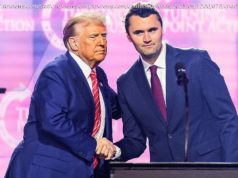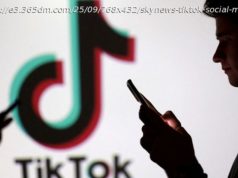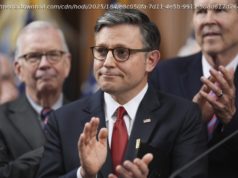The gap between short- and long-term interest rates has shrunk, and if the trend intensifies, it may be a classic harbinger of recession.
As a candidate, President Trump said he would increase United States economic growth to 4 percent annually — and in one debate even added, “I think you can go to 5 percent or 6 percent.”
Once he was in the White House, his administration revised those projections lower, saying its approach “means sustained 3 percent economic growth.”
After the economy grew by 2.3 percent in 2017, investors in some of the world’s largest markets are betting that the United States will continue to fall short of the White House goal.
The Federal Reserve has started raising short-term interest rates to reflect the economy’s recovery, but longer-term rates — over which the Fed traditionally has far less influence — have not moved nearly as much. To many in the bond markets, that suggests investors think little has changed about long-term growth prospects.
“They’re not expecting growth to move up to 3 percent on a sustained basis,” said Julia Coronado, president of Macropolicy Perspectives, an economic consulting firm. “They’re not looking for inflation to break out in any meaningful way on a sustained basis. It’s not ominous. But it does sort of confirm that investors are still seeing the world in that way.”
That does not mean the United States is about to enter a recession. By most measures, the economy is in fairly good shape as the current expansion — the second-longest on record — stretches into its ninth year. At 3.9 percent, unemployment hasn’t been this low since 2000. Corporate profits are strong. Manufacturing activity has picked up.
But with rates in Fed-sensitive short-term government bond markets rising while longer-term rates are relatively flat, the gap between them has narrowed. And the plotting of those data points, known as the yield curve, occupies an outsize space in the minds of those who consider the markets a crucial barometer of economic health.
The gap between short-term and long-term rates tends to shrink — a phenomenon known as flattening — whenever the Federal Reserve begins lifting interest rates, which the Fed started doing in December 2015. Over the last year, the gap between interest rates on 10-year and two-year Treasuries flattened from more than 1 percentage point to less than half a percentage point, its lowest point in more than a decade.
But as the yield curve flattens, long-term interest rates run the risk of falling below short-term rates, a phenomenon known as an inverted yield curve. And when the yield curve inverts, as it did most recently in 2006-7, it amounts to an economic warning from the financial markets to watch out: recession is on the way.
“We’re not there yet, but we’re getting progressively closer,” said Steven Abrahams, head of investment strategy at the broker dealer Amherst Pierpont. “And I think we will get closer, faster than the market currently anticipates.”
In a speech last month, the San Francisco Federal Reserve president, John Williams, described an inverted yield curve as “a powerful signal of recessions.”
In part, that’s because the yield curve is more than just an economic indicator. It actually helps determine decisions that are crucial to the health of the American economy. That’s because a flattening yield curve makes banking — basically the business of borrowing money at low short-term rates, and lending it at higher long-term rates — less profitable. If the yield curve inverts, it effectively slams the doors on lending. And because debt is the fuel that drives the economy’s engine, a recession often follows.
Mr. Williams stressed that he does not see an inverted yield curve, or recession, coming any time soon. And most economists agree. Over the next few years, private forecasters see United States economic growth peaking at 2.8 percent in 2018 before slowing to 2.5 percent in 2019 and 1.9 percent in 2020, according to Bloomberg data. That’s a bit faster than the 2.2 percent growth rate of the United States economy since 2012.
But it’s basically the same as the 2.6 percent average growth rate since 1980, suggesting that the $1.5 trillion tax overhaul signed into law by Mr. Trump in December is expected to have a negligible effect on long-term economic growth. Doing better would depend on increasing the supply of workers and raising productivity, a poorly understood process generally thought to depend on making large-scale investments in things like education, infrastructure and expensive equipment for companies.
Not everyone agrees that the bond market is sending a warning sign. For much of the last decade, the Federal Reserve and other central banks have been buying government bonds with the aim of pushing interest rates lower to support economic growth.
So the relatively low long-term rates partly reflect the large bond holdings of central banks, said Matthew Luzzetti, a senior economist at Deutsche Bank. That means those low rates contain “much less of a signal about negative growth in the future,” Mr. Luzzetti said.
But some view the flattening of the yield as a sign that the economy is weaker than it might appear.
Hoisington Investment Management, a bond investment firm based in Austin, Tex., has long held the view that long-term interest rates will go lower. Its chief economist, Lacy Hunt, ticked off a list of current trouble spots: slowing auto sales, skimpy inflation-adjusted wage growth, low savings rates and sluggish construction.
“There are signs out there, they don’t receive much attention,” said Mr. Hunt, whose firm manages more than $4 billion for insurance companies, nonprofit organizations and pension plans. “But the flattening of the yield curve is an indication that there is a body of people that do think the future outlook is not nearly as good as the current conditions.”






